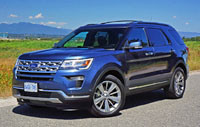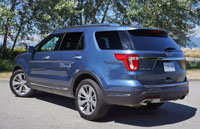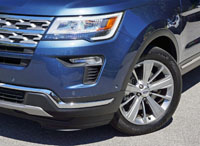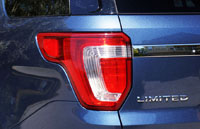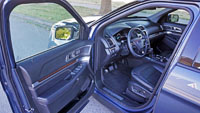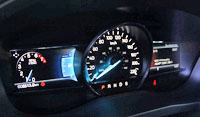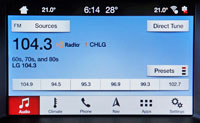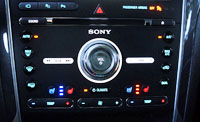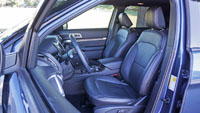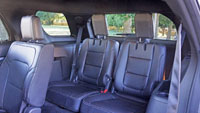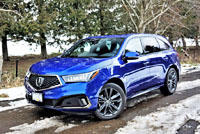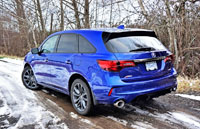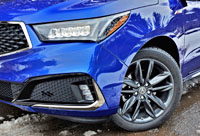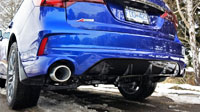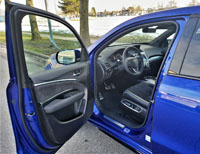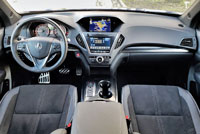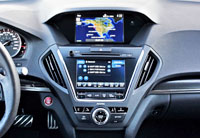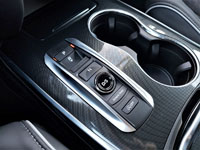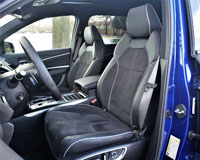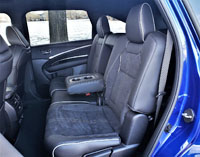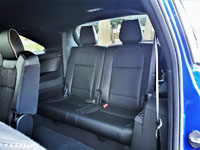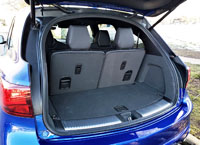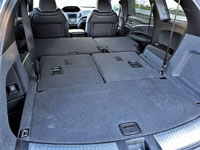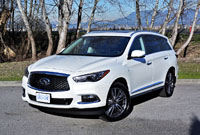
Back in the day, badge engineering was mostly a domestic issue. Certainly there were some instances of entry-level European brands sharing underpinnings with a luxury marque, but few would call an Audi Fox, which rode on the back of Volkswagen’s “mid-size” Dasher, a luxury car. The practice was more common in North America where full-size Chevy and Pontiac sedans were unabashedly transformed into Buicks and Cadillacs by grafting on new front and rear clips, stamping new sheetmetal, and gussying up their cabins with leather, faux woodgrain and chrome, but little else, which was probably why no one thought anything about luxury newcomers Acura, Lexus and Infiniti doing likewise when they arrived on the scene in the ‘80s. While these Japanese premium brands have now mostly done away with this exercise as they’ve gained more prestige, some hangers on still survive, like Infiniti’s QX60.
We can point fingers at others, like Lexus’ ES series that rests on the comfortable Toyota K platform, the same as Toyota’s Avalon, which also carries the RX and Highlander, not to mention the Camry mid-size sedan, Sienna minivan, and now discontinued Venza mid-size crossover, while Audi still shares plenty of its platform architectures with VW (and Bentley, amongst others), BMW with Mini, Alfa Romeo with Jeep, and so on, but most aren’t as obvious as Infiniti with the QX60 and Nissan’s Pathfinder.
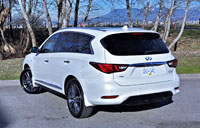
Truly, few premium models come closer to mimicking their mainstream volume-branded donor platform as the QX60 and Pathfinder, but to be fair to Infiniti the similarities aren’t easily seen outside. The luxury brand’s most accommodating crossover SUV incorporates its trademark grille and animal-like LED headlights up front, plus its curvy rear quarter window, and its more shapely wrap-around LED taillights, while the Nissan appears a lot more like a traditional truck-based SUV since it was refreshed for 2017.
No, the most noticeable similarities are found inside, where the two SUVs are near duplicates in design, layout, and overall goodness. Did you notice how I did that? No doubt you thought I was going to slam the QX60 for not measuring up to the luxury class, but despite a desire to see more differentiation between QX60 and Pathfinder interiors, they’re both very good at providing what customers in this family segment want and require, the Infiniti simply offering more when it comes to the choice and quality of materials, plus other niceties.
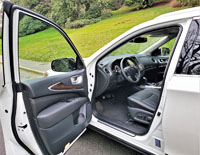
For starters, the QX60’s dash top, instrument panel fascia, glove box lid, lower console sides, and front door panels, from top to bottom, are covered in high-quality soft synthetics, while the Pathfinder is the king of hard plastics, covering each of these surfaces with low rent composites except for (oddly) the front door panels that receive the full soft-touch treatment too. The QX60 also moves these improvements into the rear passenger compartment, offering pliable rear door uppers, whereas hard shell plastic covers the Pathfinder’s inner door panels. What’s more, Infiniti covers each roof pillar in padded cloth too, while unlike some competitors Nissan doesn’t even wrap the front pillars.
Being a luxury brand, Infiniti makes other QX60 upgrades too, like replacing the Pathfinder’s faux woodgrain with genuine maple hardwood, covering the seats with high-grade leather featuring hourglass quilting on their inserts and contrasting piping around their outer edges, or at least this was the case with my tester’s top-tier Sensory trim, but the old-school electronic interfaces are near identical other than their digital branding and graphic design, the driver’s gauge package is the same except for Infiniti’s unique purple coloured theme within the dials and serrated metallic surrounds, this motif also carried over to the centre display, which just happens to not yet include Apple CarPlay or Android Auto smartphone integration, and while all the switchgear that controls these interfaces (plus everything else) are fairly unique and nicer in the more upscale QX60, they’re organized in mostly the same way.
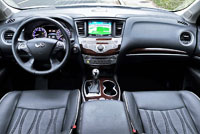
Together with the beautiful hardwood and soft leather, the $4,200 Sensory package includes three-way ventilation to the standard heated front seats, while second-row outboard positions get heated and the rearmost third row includes a powered folding return to make cargo hauling easier, while getting to that is made more convenient due to a motion activated powered tailgate. All seven QX60 occupants will likely appreciate the wide open feeling of the power panoramic sunroof up above, which comes complete with power sunshades, while they should also like this Sensory model’s 15-speaker surround-sound Bose audio upgrade, which uses digital 5.1-channel decoding, while all should also like the Advanced Climate Control System (ACCS) that includes auto-recirculation, a plasmacluster air purifier and a grape polyphenol filter. Lastly, the Sensory package enhances the QX60’s styling and road-holding with a special set of 15-spoke 20-inch alloy wheels on 235/55 all-season rubber.
Those wanting the Sensory package need to first add the $5,000 Essential package and $4,800 ProActive package, the first including remote start, entry/exit assist for the driver’s seat and steering wheel, rain-sensing windshield wipers, reverse-tilt side mirrors, two-way powered lumbar support for the driver’s seat, two-way driver’s memory with an Enhanced Intelligent Key, a 13-speaker Bose audio system, leather upholstery, Infiniti InTouch infotainment with navigation, lane guidance, and 3D building graphics, voice recognition, an Around View parking monitor with Moving Object Detection, front and rear parking sonar, SiriusXM Traffic, plus more.
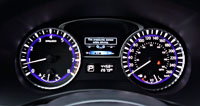
The ProActive package adds auto-dimming side mirrors, headlight high beam assist, full-speed range adaptive cruise control, distance control assist, active trace control, lane departure warning and prevention, blindspot intervention, backup collision intervention, front pre-crash seatbelts, and Infiniti’s exclusive Eco Pedal.
All of this premium equipment gets added to a QX60 that’s already nicely equipped in base Pure trim, a well-priced competitor at just $48,695, due to features like auto on/off LED headlights, LED daytime running lamps, LED fog lights, LED tail lamps, roof rails, power-folding side mirrors with integrated turn signals, proximity keyless entry, pushbutton start/stop, a heated leather-clad steering wheel rim, a power tilt and telescopic steering column, an eight-way powered driver’s seat, a six-way powered front passenger’s seat, an auto-dimming rearview mirror, a universal remote garage door opener, a (normal sized front) powered moonroof, micro-filtered three-zone auto HVAC, an 8.0-inch centre touchscreen with a reverse camera, SMS/email display, satellite radio, three USB charge ports, a power rear tailgate, predictive forward collision warning, forward emergency braking with pedestrian detection, blindspot warning, etcetera (see all 2019 and 2020 Infiniti QX60 pricing right here at CarCostCanada, with details about trims, packages and individual options, plus don’t forget to look up special manufacturer rebate info and dealer invoice pricing that could save you thousands).
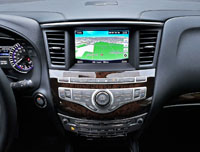
Many of these features are available with the Pathfinder, by the way, so it isn’t like top-level trims of the Nissan-branded utility aren’t up to snuff, especially when compared to their true mainstream competitors, but as it should Infiniti takes its feature allotment up a notch or two. Fortunately, not much differentiation in mechanicals is needed to remain popular, where both SUVs use the same direct-injected 3.5-litre V6 and continuously variable transmission, the latter featuring nearly real feeling stepped gear ratios. It’s one of the better CVTs available today, and ideally suited to the QX60’s comfort-oriented mission. Take note, however, that all-wheel drive comes standard with the QX60 and is optional with more basic Pathfinder trims.
Performance off the line and during passing manoeuvres is good thanks to 295 horsepower and 270 lb-ft of torque, which is 11 horsepower and 11 lb-ft more than the Pathfinder, while the CVT gets a manual mode for more spirited engagement. Additionally, Infiniti provides driving modes with default (a best of all worlds compromise), Sport (that makes adjustments to the engine and transmission to enhance performance), Eco (that adjusts engine and transmission responses to improve fuel economy), and Snow (that controls engine output to reduce wheel spin) settings, compared to the Pathfinder that only offers the choice of 2WD, AUTO, and LOCK for its “i-4×4” Intelligent 4WD system. The Pathfinder’s 4WD settings are no doubt best off the beaten path, as would be its 7.0 inches of ground clearance compared to 6.5 inches for the QX60, but Infiniti’s design is more useful for combatting slippery conditions on pavement.
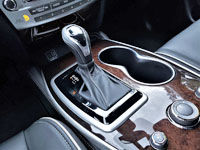
And how is fuel economy impacted? The QX60 does very well with an estimated rating of 12.5 L/100km city, 9.0 highway and 10.9 combined, while a fully loaded Pathfinder with AWD can manage a claimed 12.4 city, 9.2 highway and 11.0 combined.
Both QX60 and Pathfinder models ride on an identical fully independent suspension setups too, constructed of struts up front and a multi-link system in back, plus fore and aft stabilizer bars and coil springs, but this sameness aside the Infiniti feels more solid and substantive than the more affordable alternative. It likely comes down to some of the previously noted soft surfaces and additional sound deadening materials subduing interior noise, vibration, and harshness, not that the Pathfinder I tested recently was harsh in any way. Either way, the QX60 is more upscale, as it should be.
This more substantive presence, and suspension tuning, makes for a smoother and more comfortable ride as well, but truly both SUVs coddle their passengers well, no matter the road below, while these two can manage fast-paced curves reasonably well too, as long as no one gets unrealistically overenthusiastic.
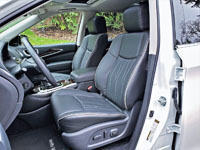
A QX60 disappointment is lumbar support, because its two-way in-and-out design (which is identical to the Pathfinder’s) simply doesn’t cut it in the premium sector. They at least should’ve made a four-way system available, because the way it is now makes it so you’ll either receive ideal pressure just where you want it, or not, the latter being reality for my five-foot-eight body type. A four-way system provides upward/downward adjustment so as to meet up with the lower backs of all types of bodies.
Two-way lumbar support aside, the driver’s seat is fairly comfortable and should be amply big in order to satisfy for most owner’s needs, while the 60/40-split second-row bench seat is plenty accommodating too, due to loads of space to each side plus fore and aft adjustability. Infiniti installed a comfortable armrest with integrated cupholders in the middle, making it a good place to idle away the hours. The QX60’s rearmost row isn’t the biggest or the smallest in this mid-size luxury segment, but it should be ample for all but large teenagers and adults. Better yet, the QX60 provides the same innovative second-row seat folding mechanism to access that third row as the Pathfinder, which allows a child safety seat to remain installed (without the child strapped in) when sliding it forward and out of the way.
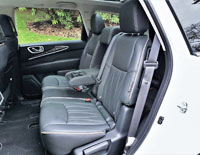
Safety seats in mind, the needs more child seat latches, especially in the very back, but on the positive the Nissan/Infiniti Rear Door Alert system is really smart. It uses door sequence logic, together with a message alert within the gauge cluster, plus multiple horn beeps, to cause its driver to check the rear compartment after parking and shutting off the ignition. It’s an important step towards reducing and hopefully eliminating child and pet injuries and deaths after being left behind in the summer heat of parked vehicles.
The QX60 is also accommodating for cargo, with a total of 447 litres (15.8 cubic feet) available aft of the third row (this area made even more functional due to a stowage compartment under the load floor), 1,155 litres (40.8 cubic feet) behind the 50/50-split third row via powered switches mounted on each cargo wall, and 2,166 litres (76.5 cubic feet) of total cargo space available when the 60/40-split second-row seats are folded forward via manual levers on their sides. Some competitors also make automated second-row seats available, but this setup should work well enough for most.
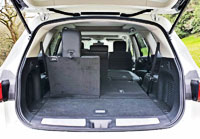
After all is said and done the QX60 is getting on in years, but aging doesn’t necessarily translate into outdated. True, its cabin electronics could use updating and, as noted earlier, I’d appreciate less obvious ties to its Pathfinder cousin, but it’s attractive from the outside in, has been finished with good quality materials, drives quite well, and provides seven-occupant luxury and plenty of practicality for an affordable price when compared to its closest premium rivals. Of note, this 2019 version is no different than the 2020 model that’s starting to arrive now, other than all the packages outlined in this review transforming into four trim levels, plus some new option packages.
This said a complete redesign isn’t far off, and expected to arrive in 2020 as a 2021 model, but if you need to upgrade now you’ll be well taken care of with this 2019 QX60, or the new 2020 version.
Story credit: Trevor Hofmann
Photo credit: Karen Tuggay

